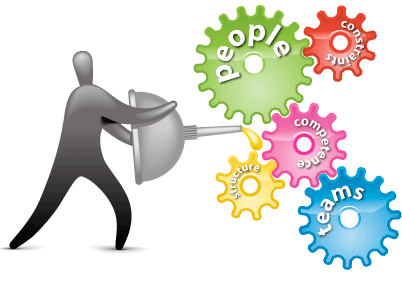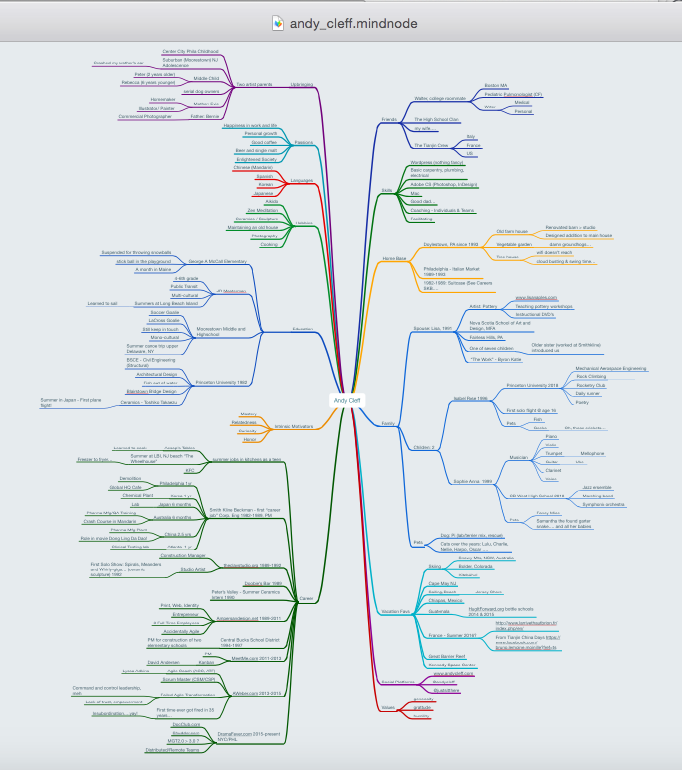Years ago I had a bit of fun on a train commute: I built a personal map.
Mind you, I was in the “quiet car,” so it was not a raucous karaoke kind of fun. More inside-my-own-head kind of fun.
“Why?” you ask. Let me first explain the “What.”
What is personal cartography?
You may be familiar with the concept of a “journey map” often used at retrospectives or team-building events. A personal map is similar but with a few differences. Both sketch significant events from one’s past. And while a journey map has a time scale on the x-axis, and a morale scale on the y-axis, a personal map has neither time nor emotion dimensions. It takes the form of a concept or spider diagram (you may also call the format a mind map). It’s a journey map on steroids – a visual organization of the attributes, relationships, and experiences that make me, well, me.
Lucky me. Another day on the outside. Click To Tweet
To get started mapping, I downloaded an app – MindNode – and in the center of the screen added a box for me. I then branched out with a few simple categories, inspired by a map I had seen from Louise Brace: friends, family, hobbies, work, and education.
And I just kept going. I don’t know what my seatmate thought as she glanced at my screen… “Uh oh, sitting next to ‘Mr. Beautiful Mind’…” By the time I reached my destination an hour later, I had over a dozen main branches fanning out to places, people and things that bubbled up out of the deep, dark recesses of my mind.
I only wish the app allowed a few additional categories of data input: smells, which are such a powerful trigger of memory (my Nanna Rae making cinnamon toast); snippets of audio from a car radio or a friend’s voice. MindNode and similar apps all support images – maybe someday I’ll add photographs that currently live in a shoebox somewhere in the attic.
Anyway, I got off the train and my seatmate had not called ahead, so there were no nice men in clean white jackets waiting for me with a padded van at my destination. Lucky me. Another day on the outside.
Ok, back to “Why?”
Bear with me, as this is going to be a bit of a meander…
I had recently begun working with highly distributed teams and was growing my skills in providing coaching and facilitation with regard to virtual team effectiveness. I did a lot of research and learning about the topic.
I had just finished reading Hassan Osman’s short but powerful book: Influencing Virtual Teams: 17 Tactics That Get Things Done with Your Remote Employees (2014). In the book, Osman reveals “the secret formula” for trust in teams:
- Trust = reliability + like-ability
He elaborates that likeability is created by “the forming of emotional ties between members of a team…. the result of social bonds developed in a reciprocal relationship between two people.”
Osman then goes on to provide five steps to help increase the potential for likability in a team. The first one:
- Get personal
(For the other four steps, grab the book 😛 )
Well, how the heck am I going to “get personal”? I can’t exactly decrease the physical distance between all of my virtual teammates’ desks… and I can’t be flying everyone in for Kumbaya sessions every month.
Trust = reliability + like-ability #teamwork Click To TweetFortunately, around the same time I was reading Osman’s book, I came across Louise’s Happy Melly post that I mentioned earlier and that seemed to provide a solution: Personal Maps with a bit more detail on the M3.0 website.
“Interesting,” I thought. “I ought to take this for a test flight…” This brings me back to the beginning of this post… me on the train creating my very first personal map. (Sorry for the mixed modes of transportation…)
All aboard
Having completed my own map, I saw clearly the potential in having team members do the same. Sharing that level of history and backstory will create a starting point for getting to know each other on a whole other level. It will be like a mini team-building trip to the mountains, without the travel time or mosquitos.
And when team members understand each other better, when they appreciate the uniqueness of each other, they can decrease their mental distance. And get personal.
And with that comes the potential for better collaboration, communication, and trust – a few of the key ingredients necessary to sustain high-performance teams.
Here’s a ticket

Reach out to a team member or two that you want to get to know better.
Fire up a digital collaboration tool like Miro.com which has mind maps built-in.
Pick a few categories that will help paint a snapshot of what makes each of you you. (There’s a list below of possible starters.)
Set a time-box of perhaps 20 minutes and go.
Then share. Discuss. Learn.
Starter Categories for Personal Maps
artists
books
career skills
education
family (partners, kids)
food
goals, ambitions
hobbies
home base
languages
motivators
movies
music
passions
pets
quirks
social – www, twitter, podcasts
talents
upbringing
vacation plans
values
anything you want
Bring your whole self to work. Share what you come up with….. I’d be happy to get to know you better…



Nice summary of personal maps. Sharing this out to a few folks.
Thanks, Andy. very interesting read and something I would like to try 🙂 Thanks for sharing